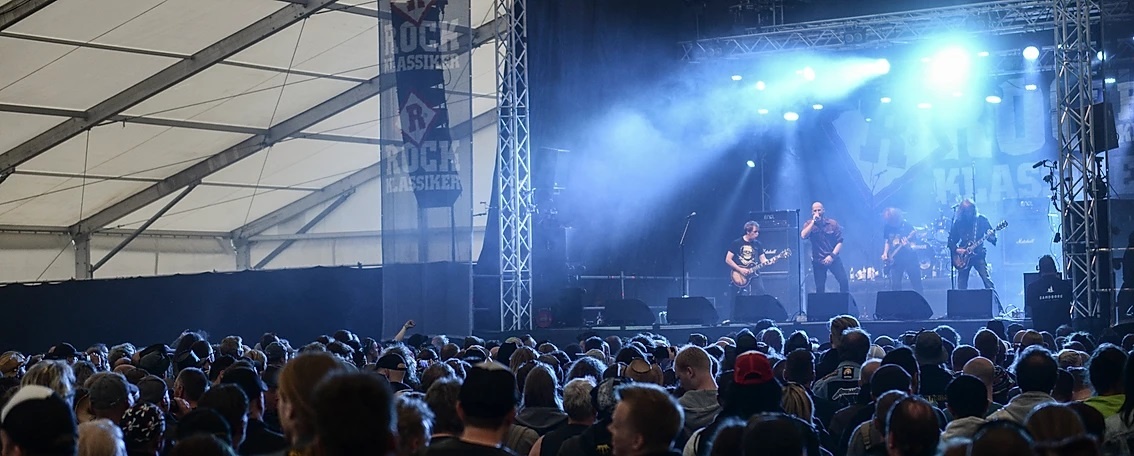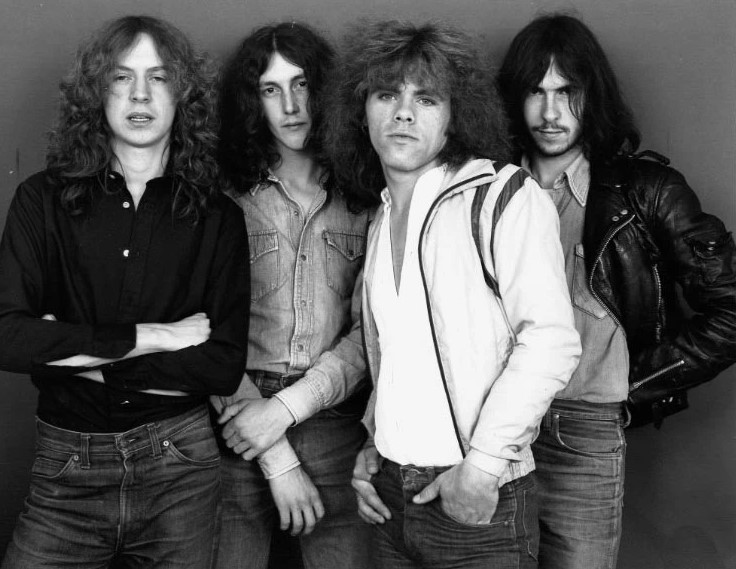Diamond Head
Diamond Head
OVERVIEW
| ORIGIN | United Kingdom |
| GENRES | Heavy Metal |
| ACTIVE | 1976 – Present |
| LABELS | Happy Face
MCA Records Castle Music Cargo Records Dissonance Productions Silver Lining Music |
| ASSOCIATED ACTS |
Metallica
Megadeth Blitzkrieg Angel Witch Witchfinder General
|
MEMBERS
Rasmus Bom Andersen / Vocals
Brian Tatler / Guitar
Andy Abberley / Guitar
Karl Wilcox / Drums
Dean Ashton / Bass
STARTING OUT
It starts with a heavy thud, and moves into a fast moving riff. It crackles on the stereo as a diamond reflects back at you on the album cover. It, is “Lightning to the Nations,” the first song on Diamond Head’s debut album alternately known as the White Album and Lightning to the Nations. This was the album that contained songs such as the title track, “Helpless,” “The Prince,” and “Am I Evil,” that would inspire an entire generation of kids to pick up their guitars and mics and form bands.
“New Wave of British Heavy Metal”
It was an album that combined the best of punk with the best of metal, that made up the core of the New Wave of British Heavy Metal. To cap it all off, this album and this band are responsible for the later formation of Metallica. As has been noted elsewhere, Metallica started off as a cover band, that would mainly cover Diamond Head songs. But just who were Diamond Head and what happened to them?
Diamond Head were formed in 1976 in Stourbridge, the West Midlands town in the middle of nowhere. The two founding members were Duncan Scott on drums and Brian Tatler on guitar. The name Diamond Head, Tatler says came from a poster he had on his wall at home, which had that name engraved on it. From it being just the two of them, Scott and Tatler would soon begin playing covers whilst auditioning for various singers, before they then found Sean Harris. From there the band began recording various demos, which got them noticed and they were considered enough of a draw to go on tours with AC/DC and Iron Maiden as support.
“Carve a niche”
At this point in time, with the New Wave of British Heavy Metal exploding around them Diamond Head would go onto carve a niche for themselves as a progressive metal band, with a phenomenal live show. They were being managed at the time by Harris’ mother Linda who reportedly turned down an offer from the prestigious Leiber/Krebs management, which meant the band were still unsigned whilst others were getting signed on going on their own tours.
Eventually, however, Diamond Head managed to get two of their singles released on Media Records, before releasing their debut album on Happy Face. Though a mishap in the distribution only meant that a limited number of copies were produced and released. The band would go onto consider this a demo, due to the desire to attract attention from record labels.
Eventually, after facing the fact that management had not promoted the record whatsoever, and the fact that most of the press was being driven by word of mouth in the underground and through their live shows, Diamond Head managed to attract the attention of MCA Records who signed the band. What followed was the release of Four Cuts EP and a slot on the Reading Festival-back when Reading was good- and then the release of Borrowed Time. Borrowed Time went in a more progressive direction and appealed to a wide audience, getting to number 24 on the UK charts, and allowing the band to go on their own headline tour in premier venues such as the Hammersmith Odeon.
“Hit by problems”
On their next album, Diamond Head tried a more experimental sound, the record has some interesting songs such as “The Kingmaker,” and “Knight of the Swords,” but was once again hit by problems, an issue during the pressing of the vinyl caused the record to jump somewhat. And the response to the record on a whole was somewhat mixed. As time wore on, it seemed according to Tatler that some of the members either weren’t improving quickly enough or found the band too much work, and therefore, things were beginning to fracture. In 1984, Diamond Head called time on their career, for lack of funds and a lack of interest from record labels.
Diamond Head’s disbandment was symptomatic of the New Wave of British Heavy Metal scene which the band had been a part of. What started off with a bang usually ended up in a whimper as many bands found their initial success hard to build on. Whether this was due to poor management, the changing tastes in the music industry or just general bad luck, is hard to tell. However, as with many other bands from this period, Diamond Head had left a big mark on the metal scene. Indeed, over the States, Lars Ulrich who had once followed the band around on tour in the UK and had slept in Tatler’s house, would go on to acknowledge Diamond Head as a huge influence on his career.
“Reformation of the band”
Such praise drew attention to the band, as did the fact that Metallica had regularly covered songs by Diamond Head during their career. This combined with a renewal of interest in the New Wave of British Heavy Metal during the 1990s, sparked the reformation of the band. With Diamond Head coming on stage during Metallica’s show in 1992 at the NEC in Birmingham to perform a few of their songs followed shortly afterwards with their first big gig being in 1993 at the Milton Keynes Bowl, opening for Metallica.
The band also released an album entitled Death and Progress, in 1993, which was well received, however, old tensions soon flared up and the band disbanded in 1994, and would not reform again until 2000.
In 2000, the band reformed but with just Harris and Tatler and began performing some acoustic shows before picking up again electrically with former members Karl Wilcox and Eddie Moohan on drums and bass respectively. They performed their first live show in America at Metal Meltdown IV in New Jersey, and even began recording a new album, before tensions resurfaced. Harris allegedly said he did not wish to use the Diamond Head name anymore or be associated with metal, shortly afterwards he left the band.
This time though, the remaining members decided they did not want to disband, instead Nick Tart was chosen as the new singer and two albums were released with Tart. These albums being All Will Be Revealed and What’s In Your Head. The band under went quite the transformation during this period, playing shows across the world, and getting a primetime slot in big festivals such as Sonisphere in 2011 and performing with the Big Four of Thrash Metal at the same festival. However, due to the struggles of performing and recording with Tart who lived in Australia, the band parted ways in the 2010s, with Tart being replaced by Rasmus Andersen.
“Defiant statement of intent”
With Andersen, Diamond Head have had two highly successful albums, their self titled which was released in 2016, which was defiant statement of intent, and their newest release The Coffin Train. The latter album debuted at Number 5 on the UK Rock album charts, much higher than their self titled had debuted in 2016. The band has also embarked on tours across the world consistently during the 2010s, and continues to draw a big audience to their shows.
Diamond Head are a band who helped shape a genre in the 80s, they were a band who helped give rise to bands such as Metallica and Megadeth. Their continued output in the modern day shows that they are a high quality band with some serious strengths. Their initial lack of success at first was unfortunate, and as such, one can only ponder on the what ifs, however, their modern day incarnation is sure to stand the test of time.
OVERVIEW
| ORIGIN | United Kingdom |
| GENRE | Heavy Metal |
| ACTIVE | 1975 – Present |
| LABELS | Happy Face
MCA Records Castle Music Cargo Records Dissonance Productions Silver Lining Music |
| ASSOCIATED ACTS |
Metallica
Megadeth Blitzkrieg Jaguar Witchfinder General Angel Witch
|
MEMBERS
Rasmus Bom Andersen / Vocals
Brian Tatler / Guitar
Andy Abberley / Guitar
Karl Wilcox / Drums
Dean Ashton / Bass
STARTING OUT
It starts with a heavy thud, and moves into a fast moving riff. It crackles on the stereo as a diamond reflects back at you on the album cover. It, is “Lightning to the Nations,” the first song on Diamond Head’s debut album alternately known as the White Album and Lightning to the Nations. This was the album that contained songs such as the title track, “Helpless,” “The Prince,” and “Am I Evil,” that would inspire an entire generation of kids to pick up their guitars and mics and form bands.
“New Wave of British Heavy Metal”
It was an album that combined the best of punk with the best of metal, that made up the core of the New Wave of British Heavy Metal. To cap it all off, this album and this band are responsible for the later formation of Metallica. As has been noted elsewhere, Metallica started off as a cover band, that would mainly cover Diamond Head songs. But just who were Diamond Head and what happened to them?
Diamond Head were formed in 1976 in Stourbridge, the West Midlands town in the middle of nowhere. The two founding members were Duncan Scott on drums and Brian Tatler on guitar. The name Diamond Head, Tatler says came from a poster he had on his wall at home, which had that name engraved on it. From it being just the two of them, Scott and Tatler would soon begin playing covers whilst auditioning for various singers, before they then found Sean Harris. From there the band began recording various demos, which got them noticed and they were considered enough of a draw to go on tours with AC/DC and Iron Maiden as support.
” go onto carve a niche”
At this point in time, with the New Wave of British Heavy Metal exploding around them Diamond Head would go onto carve a niche for themselves as a progressive metal band, with a phenomenal live show. They were being managed at the time by Harris’ mother Linda who reportedly turned down an offer from the prestigious Leiber/Krebs management, which meant the band were still unsigned whilst others were getting signed on going on their own tours.
Eventually, however, Diamond Head managed to get two of their singles released on Media Records, before releasing their debut album on Happy Face. Though a mishap in the distribution only meant that a limited number of copies were produced and released. The band would go onto consider this a demo, due to the desire to attract attention from record labels.
“MCA Records “
Eventually, after facing the fact that management had not promoted the record whatsoever, and the fact that most of the press was being driven by word of mouth in the underground and through their live shows, Diamond Head managed to attract the attention of MCA Records who signed the band. What followed was the release of Four Cuts EP and a slot on the Reading Festival-back when Reading was good- and then the release of Borrowed Time. Borrowed Time went in a more progressive direction and appealed to a wide audience, getting to number 24 on the UK charts, and allowing the band to go on their own headline tour in premier venues such as the Hammersmith Odeon.
“Hit by problems”
On their next album, Diamond Head tried a more experimental sound, the record has some interesting songs such as “The Kingmaker,” and “Knight of the Swords,” but was once again hit by problems, an issue during the pressing of the vinyl caused the record to jump somewhat. And the response to the record on a whole was somewhat mixed. As time wore on, it seemed according to Tatler that some of the members either weren’t improving quickly enough or found the band too much work, and therefore, things were beginning to fracture. In 1984, Diamond Head called time on their career, for lack of funds and a lack of interest from record labels.
“Left a big mark”
Diamond Head’s disbandment was symptomatic of the New Wave of British Heavy Metal scene which the band had been a part of. What started off with a bang usually ended up in a whimper as many bands found their initial success hard to build on. Whether this was due to poor management, the changing tastes in the music industry or just general bad luck, is hard to tell. However, as with many other bands from this period, Diamond Head had left a big mark on the metal scene. Indeed, over the States, Lars Ulrich who had once followed the band around on tour in the UK and had slept in Tatler’s house, would go on to acknowledge Diamond Head as a huge influence on his career.
“Reformation of the band”
Such praise drew attention to the band, as did the fact that Metallica had regularly covered songs by Diamond Head during their career. This combined with a renewal of interest in the New Wave of British Heavy Metal during the 1990s, sparked the reformation of the band. With Diamond Head coming on stage during Metallica’s show in 1992 at the NEC in Birmingham to perform a few of their songs followed shortly afterwards with their first big gig being in 1993 at the Milton Keynes Bowl, opening for Metallica.
The band also released an album entitled Death and Progress, in 1993, which was well received, however, old tensions soon flared up and the band disbanded in 1994, and would not reform again until 2000.
“First live show”
In 2000, the band reformed but with just Harris and Tatler and began performing some acoustic shows before picking up again electrically with former members Karl Wilcox and Eddie Moohan on drums and bass respectively. They performed their first live show in America at Metal Meltdown IV in New Jersey, and even began recording a new album, before tensions resurfaced. Harris allegedly said he did not wish to use the Diamond Head name anymore or be associated with metal, shortly afterwards he left the band.
This time though, the remaining members decided they did not want to disband, instead Nick Tart was chosen as the new singer and two albums were released with Tart. These albums being All Will Be Revealed and What’s In Your Head. The band under went quite the transformation during this period, playing shows across the world, and getting a primetime slot in big festivals such as Sonisphere in 2011 and performing with the Big Four of Thrash Metal at the same festival. However, due to the struggles of performing and recording with Tart who lived in Australia, the band parted ways in the 2010s, with Tart being replaced by Rasmus Andersen.
“Defiant statement of intent”
With Andersen, Diamond Head have had two highly successful albums, their self titled which was released in 2016, which was defiant statement of intent, and their newest release The Coffin Train. The latter album debuted at Number 5 on the UK Rock album charts, much higher than their self titled had debuted in 2016. The band has also embarked on tours across the world consistently during the 2010s, and continues to draw a big audience to their shows.
Diamond Head are a band who helped shape a genre in the 80s, they were a band who helped give rise to bands such as Metallica and Megadeth. Their continued output in the modern day shows that they are a high quality band with some serious strengths. Their initial lack of success at first was unfortunate, and as such, one can only ponder on the what ifs, however, their modern day incarnation is sure to stand the test of time.














